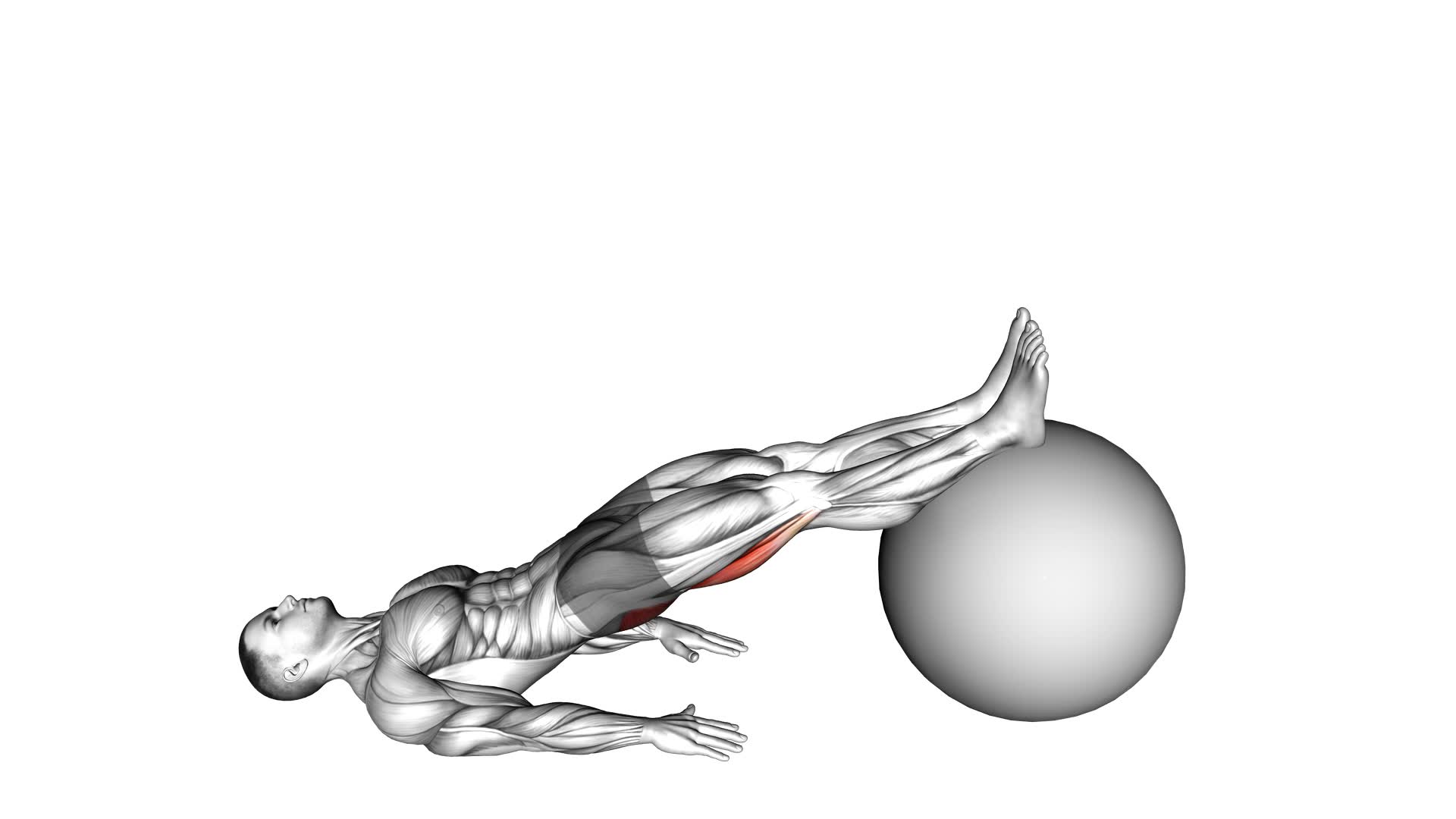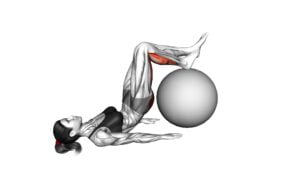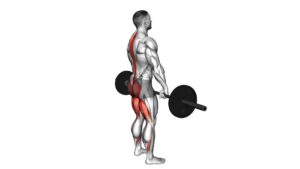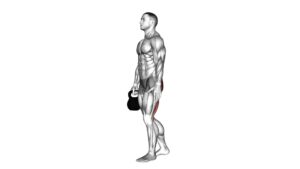Exercise Ball One Legged Diagonal Kick Hamstring Curl – Video Exercise Guide & Tips

Looking to strengthen your hamstrings and improve your balance? Try the exercise ball one-legged diagonal kick hamstring curl!
Watch This Exercise Video
In this video exercise guide, we'll show you the proper form and technique for this challenging move. You'll also learn common mistakes to avoid and variations to keep your routine interesting.
Incorporate the exercise ball one-legged diagonal kick hamstring curl into your workout routine for stronger, more toned legs.
Let's get started!
Key Takeaways
- The exercise ball one legged diagonal kick hamstring curl targets and strengthens the hamstrings while improving knee stability and lower body strength.
- This exercise can help prevent injuries and enhance athletic performance.
- Modifications can be made to suit different fitness levels, and it improves balance and stability.
- Proper form and technique include engaging the core, maintaining control, and avoiding common mistakes such as not engaging the core properly or struggling with balance.
Benefits of the Exercise Ball One Legged Diagonal Kick Hamstring Curl
The Exercise Ball One Legged Diagonal Kick Hamstring Curl provides a challenging and effective workout for your hamstrings through the use of an exercise ball and compound preposition. This exercise offers numerous benefits for your lower body strength and stability.
One of the main advantages is that it targets and strengthens your hamstrings, which are crucial muscles for knee stability and overall lower body strength. By performing this exercise regularly, you can improve your hamstring strength, which can help prevent injuries and enhance your athletic performance.
Additionally, the Exercise Ball One Legged Diagonal Kick Hamstring Curl allows for modifications to suit different fitness levels. If you're a beginner, you can start by using a lighter exercise ball or performing the exercise without any added weight. As you progress, you can increase the difficulty by using a larger exercise ball or adding weights to challenge your muscles further.
Incorporating this exercise into your workout routine can also improve your balance and stability. The one-legged aspect of the exercise engages your core muscles and forces them to work harder to maintain stability. This can enhance your overall balance and stability, helping you in various daily activities and sports.
Transitioning into the subsequent section about proper form and technique for the Exercise Ball One Legged Diagonal Kick Hamstring Curl, it's important to understand the correct execution of this exercise to maximize its benefits and minimize the risk of injury.
Proper Form and Technique for the Exercise Ball One Legged Diagonal Kick Hamstring Curl
To execute the Exercise Ball One Legged Diagonal Kick Hamstring Curl with proper form and technique, focus on maintaining stability and engaging your core muscles throughout the movement. This exercise is great for improving balance and targeting your hamstring muscles.
Here are some key tips to ensure you perform this exercise correctly:
- Start by lying on your back with your feet on the exercise ball and your arms by your sides.
- Lift one leg off the ball and extend it towards the ceiling, keeping your knee slightly bent.
- Engage your core and press your other foot into the ball for stability.
- Slowly lower your hips towards the floor while maintaining control and keeping your core engaged.
- Curl the ball towards your glutes by bending your knee and contracting your hamstring muscles.
- Pause for a moment at the top of the movement, then slowly straighten your leg and return to the starting position.
- Repeat the exercise for the desired number of repetitions, then switch legs and repeat on the other side.
Remember to breathe throughout the exercise and focus on maintaining proper form to maximize the benefits for your balance and hamstring muscles.
Common Mistakes to Avoid When Performing the Exercise Ball One Legged Diagonal Kick Hamstring Curl
When performing the Exercise Ball One Legged Diagonal Kick Hamstring Curl, it's important to avoid these common mistakes.
One common mistake isn't engaging your core muscles properly. It's essential to keep your core tight throughout the exercise to maintain balance and stability.
Another mistake to avoid isn't maintaining proper form. Make sure your hips are lifted and your body is in a straight line from your head to your heels. Avoid arching your back or letting your hips sag.
Additionally, beginners often struggle with the balance required for this exercise. To modify for beginners, you can start by performing the movement without the exercise ball, keeping both feet on the ground. This will help you build stability and strength before progressing to the full exercise.
Remember to start with a lighter resistance band or no band at all, and gradually increase the intensity as you become more comfortable and confident.
Variations and Progressions for the Exercise Ball One Legged Diagonal Kick Hamstring Curl
Engaging your core muscles properly and maintaining proper form are crucial when performing variations and progressions for the Exercise Ball One Legged Diagonal Kick Hamstring Curl.
To continue challenging your muscles and improving your strength and stability, here are some progressions and modifications you can try:
- Increased Range of Motion: Start by performing the exercise with a smaller range of motion, and gradually increase it as you become more comfortable. This will further engage your hamstrings and glutes, providing a greater challenge.
- Single-Leg Balance: Once you have mastered the basic exercise, try performing it while balancing on one leg. This won't only target your hamstrings and glutes but also improve your overall balance and stability.
- Resistance Band: Add a resistance band around your thighs to increase the difficulty of the exercise. The band will provide external resistance, forcing your muscles to work harder.
Remember, it's important to progress gradually and listen to your body. If you feel any pain or discomfort, modify the exercise accordingly. Always consult with a fitness professional for guidance and ensure proper form to prevent injuries.
Tips for Incorporating the Exercise Ball One Legged Diagonal Kick Hamstring Curl Into Your Workout Routine
To incorporate the Exercise Ball One Legged Diagonal Kick Hamstring Curl into your workout routine, focus on maintaining proper form and engaging your core muscles throughout the exercise. This exercise is a great way to strengthen your hamstrings while also engaging your core and improving balance.
To begin, start by lying on your back with your arms extended by your sides and your feet resting on the exercise ball. Lift one leg off the ball and extend it straight up towards the ceiling. This will be your starting position.
From here, engage your core and exhale as you bend your knee and bring the exercise ball diagonally towards your opposite shoulder. As you do this, focus on keeping your hips and lower back stable and avoid arching or twisting your spine. Inhale as you slowly return to the starting position and repeat on the other side.
When incorporating the Exercise Ball One Legged Diagonal Kick Hamstring Curl into your workout routine, it's important to start with a weight and difficulty level that's appropriate for your fitness level. As you become stronger and more comfortable with the exercise, you can gradually increase the weight or difficulty by using a heavier exercise ball or adding ankle weights.
Incorporating the exercise ball into your core workouts is a great way to add variety and challenge to your routine. By engaging your core muscles throughout the exercise, you won't only strengthen your hamstrings but also improve your overall stability and balance. Remember to always listen to your body and modify or progress the exercise as needed.
Frequently Asked Questions
How Many Sets and Repetitions Should I Do for the Exercise Ball One Legged Diagonal Kick Hamstring Curl?
To determine the optimal sets and repetitions for the exercise ball one legged diagonal kick hamstring curl, you need to consider your fitness level and goals. It's important to start with a weight and intensity that challenges you, but allows you to maintain proper form. Gradually increase the difficulty by adding more sets or repetitions.
As you progress, you can also try variations of the exercise, such as adding resistance bands or performing the movement on a stability ball.
Can I Perform the Exercise Ball One Legged Diagonal Kick Hamstring Curl if I Have Knee or Lower Back Issues?
If you're dealing with knee or lower back issues, it's important to be cautious when performing the exercise ball one legged diagonal kick hamstring curl.
There are alternative exercises that can be beneficial for you. You may want to consider modifications that are less intense on your knees and lower back.
It's always best to consult with a professional or a physical therapist who can provide you with specific recommendations based on your individual needs and limitations.
Is It Necessary to Use an Exercise Ball for the One Legged Diagonal Kick Hamstring Curl, or Can I Do It Without One?
To answer your question, yes, it's possible to perform the one-legged diagonal kick hamstring curl without using an exercise ball. You can use alternative equipment or modify the exercise for beginners.
However, keep in mind that the exercise ball provides added stability and engages more muscles. If you have knee or lower back issues, it's recommended to consult with a fitness professional or physical therapist before attempting this exercise without the ball.
Can I Do This Exercise as a Warm-Up Before My Main Workout?
Yes, you can definitely use this exercise as a warm-up before your main workout.
However, there are also alternative warm-up exercises you can consider.
Incorporating dynamic stretching into your warm-up routine has many benefits, such as increasing blood flow to your muscles and improving flexibility.
It prepares your body for the more intense exercises to come and reduces the risk of injury.
Are There Any Specific Breathing Techniques I Should Follow While Doing the Exercise Ball One Legged Diagonal Kick Hamstring Curl?
When performing the exercise ball one legged diagonal kick hamstring curl, it's important to focus on your breathing techniques. Proper breathing can enhance the effectiveness of the exercise and help you maintain control and stability.
By inhaling deeply during the eccentric phase and exhaling during the concentric phase, you can engage your core muscles and promote better oxygen flow throughout your body.
Additionally, using an exercise ball adds an extra challenge and helps improve balance and stability.
Conclusion
Overall, the exercise ball one-legged diagonal kick hamstring curl is a highly effective exercise for strengthening the hamstrings and improving balance and stability.
By following proper form and technique, you can maximize the benefits of this exercise while avoiding common mistakes.
Additionally, incorporating variations and progressions can further challenge your muscles.
Remember to consult with a fitness professional before starting any new exercise routine to ensure it's suitable for your fitness level.

Author
Years ago, the spark of my life’s passion ignited in my mind the moment I stepped into the local gym for the first time. The inaugural bead of perspiration, the initial endeavor, the very first surge of endorphins, and a sense of pride that washed over me post-workout marked the beginning of my deep-seated interest in strength sports, fitness, and sports nutrition. This very curiosity blossomed rapidly into a profound fascination, propelling me to earn a Master’s degree in Physical Education from the Academy of Physical Education in Krakow, followed by a Sports Manager diploma from the Jagiellonian University. My journey of growth led me to gain more specialized qualifications, such as being a certified personal trainer with a focus on sports dietetics, a lifeguard, and an instructor for wellness and corrective gymnastics. Theoretical knowledge paired seamlessly with practical experience, reinforcing my belief that the transformation of individuals under my guidance was also a reflection of my personal growth. This belief holds true even today. Each day, I strive to push the boundaries and explore new realms. These realms gently elevate me to greater heights. The unique combination of passion for my field and the continuous quest for growth fuels my drive to break new ground.







